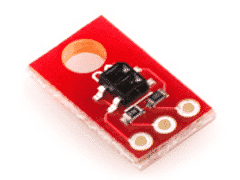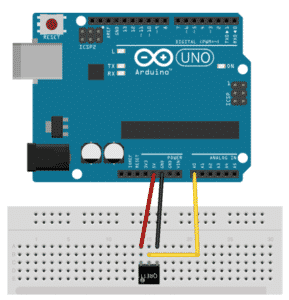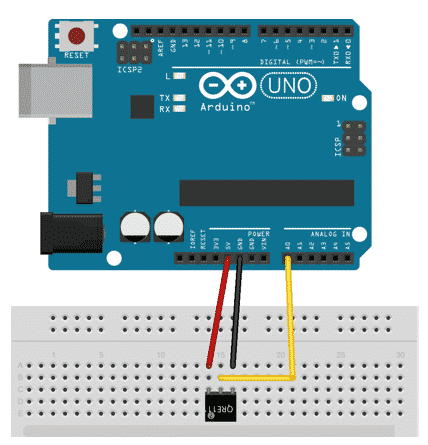An infrared line sensor is a simple device made up of an infrared emitting LED and an infrared sensitive photo-resistor.
You could use one of these sensors to build a robot that follows a dark line on the floor, or your own heart rate monitor.
The principle of operation is very simple: The transmitter produces infrared light which bounces of a surface and comes back to be captured by the photo-resistor.
The more infrared light is reflected back into the photo-resistor, the higher the output of the sensor gets.
In our experiment we will use a QRE1113 line sensor from Sparkfun. You can get something like this on eBay for less than $2.
Let's puts together this circuit and test out the motion sensor.
We will need:
- The Arduino
- Three jumper wires
- An QRE1113 line sensor or equivalent (like this ywRobot device).
Here's what we are going to build (below).
For power, you can plug this sensor into either the 3V or 5V sockets on the Arduino.
This one is very simple, just read the analog output at pin A0 and print it to the monitor (here is the sketch on Github):
// Line Sensor Breakout - Analog
int out;
void setup()
{
Serial.begin(9600); // sets the serial port to 9600
}
void loop()
{
out = analogRead(0); // read analog input pin 0
Serial.println(out, DEC); // print the value of the sensor
delay(100); // wait 100ms for next reading
}
First, create the variable that will hold the value from the analog pin, named out.
Inside void setup(), we set the Serial port to 9600 baud rate so that the sensor values can be displayed on the serial monitor while the sketch is running.
Inside the loop() function we read the input from analog pin 0 (A0) and store it in the out variable.
We display the value in the Serial monitor using the Serial.println(out, DEC) command. We use println() (instead of just print()) to display each value in a new line. We use the DEC parameter inside the println() command to display the value as a decimal.
We introduce a 100ms delay to reduce the rate by which the sensor is read.



